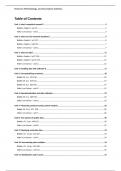Summary
Summary Research Methodology and Descriptive Statistics test 1, pre-master BA, University of Twente
- Course
- Institution
- Book
Summary of complete course material (book chapters per unit, as well as videos and other recommended teaching materials). Test 1 Research Methodology and Descriptive Statistics, University of Twente, University of Twente. Pre-Master's in Business Administration
[Show more]




